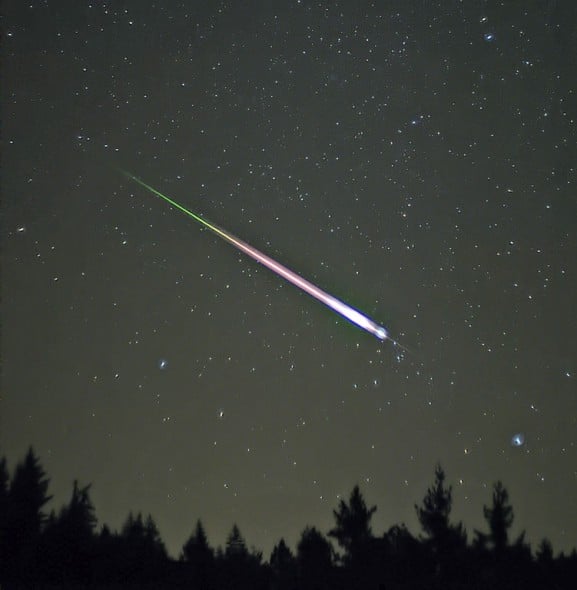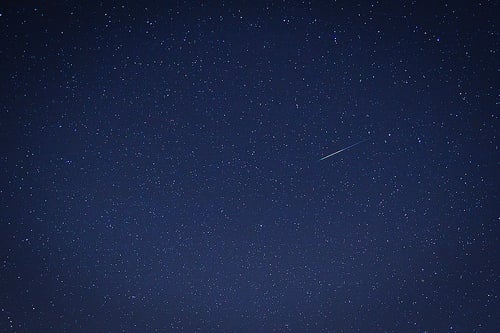As the Leonid Meteor Shower peaks on Wednesday November 18th, we offer a quick guide to capturing unforgettable shots
Meteor showers don’t come along every day, and if you’ve got any interest in astrophotography then it’s well worth grabbing the chance to shoot one. Next week will see the arrival of the Leonid Meteor Shower. It’s expected to peak on November 17th to 18th and the waxing moon will mean a nice dark sky to see the show against.
If you’re up for trying to get some shots of the meteors, then your best bet is going to be after midnight – an early evening nap is a good idea if you can, otherwise get the coffee on!
A tripod is a must, and a fast wide-angle lens will allow you to capture an expansive field of view while letting in as much light as possible. A remote shutter release can also be handy, as it will allow you to capture nice long exposures without running the risk of causing camera-shake by pressing the shutter button.
Getting the right gear is only half the battle though – after all that, you still need to knuckle down and shoot the things. We got in touch with Chris Grimmer, author of our deep-space photography guide and astrophotography expert, for some tips on how to photograph the show…

A detail shot of a Leonid meteor by Navicore Meteor Photos.
Chris Grimmer’s Five Tips for Photographing the Leonid Meteor Shower
Meteor showers are amazing things to see, and each shower has its own unique traits. The Leonids are fast-moving meteors that radiate from the constellation of Leo, which will be lying due east in the early hours. The meteors will actually appear all across the sky, but moving away from that general area.
Here are a few tips on how to capture the meteor shower:
1. Location
A dark location is crucial for any form of night sky photography. A camera is a lot more sensitive to stray light that the human eye and will pick up street lighting from miles away. So the further you can get away from cities/towns the better.
2. Planning
Plan your night, find suitable locations and check them out in daylight (if you haven’t been there before) as everything gets more difficult in the dark, especially finding your way around. Watch the weather as clear skies are essential, keep a close eye on the satellite maps for cloud cover (Sat24 is a handy website) as you may spot that clear patch and then head to the location that will give you the best chance.
3. Composition
Don’t forget the foreground. Although the main subject is the meteors, don’t forget to include something in the image to link the sky and the foreground, this can turn a good image into something special.
4. Focusing
Autofocus is useless under dark conditions, so get used to using manual focus. Most lenses will show ‘infinity’ on the focusing ring, however this will not give perfect focus. If your camera has live view, aim at a bright star, push your ISO high and use the Zoom function on your LCD screen to get in close to a bright star. Now adjust the focus until the star appears as small as possible. Alternatively use the same method but take a couple of second image, adjust focus and take another image. Keep doing this until you have focus as close as possible.
5. Settings
A lot of this will depend on your camera and lens, but these are a good starting point.
ISO – I’d say use a setting of around 800 to 1600, depending on how well your camera handles noise.
White balance – tungsten or fluorescent both work pretty well and help to reduce the orange skyglow.
Aperture – as wide as your lens will go.
Exposure – as long as possible before you get star trailing. The shorter the focal length, the longer the exposure you can take. This is what is known as the “500 Rule”. Follow this rule and you should be able to keep your stars nice and round:
The 500 Rule
500 divided by the focal length of your lens = The longest exposure in seconds you can take before stars start to trail. (remember to multiply your focal length by 1.5/1.6 for crop sensors)

Image of the Quadrantid Meteor Shower by Flickr user Donovan Shortey
A final point: dress for the weather. It may be mild at the moment, but when you are standing around in the middle of the night you quickly lose heat, so warm clothes and a hat are a must.
Above all, a meteor shower is a stunning sight, so don’t forget to look up and enjoy.

